Author: Jordan Folks
Brewers commonly acidify their mash to ensure it falls within the range of 5.2 to 5.6 pH, which is said to promote proper conversion of starches to fermentable sugar while promoting flavor stability in the finished beer. However, understanding that dry hopping tends to increase the pH of beer, a growing cadre of IPA brewers have begun adding exogenous acid to wort following the boil as a way to avoid “flabby” or other unpleasant characteristics.
Depending on the style of beer, wort pH following the boil is typically between 5.0 and 5.5, and similar to mash pH, paler styles tend toward the higher end of this range. While one rule of thumb is to acidify IPA wort to 5.0 pH, some recommend going as low as 4.0 pH for beers with particularly large dry hop additions, which can be accomplished with any acid commonly used in brewing such as phosphoric and lactic.
Since I first learned about this technique, I’ve made acidifying my wort following the boil a part of my standard operating procedure when making IPA as well as lagers. Curious of the impact this method was having, I designed an xBmt to test it out for myself.
| PURPOSE |
To evaluate the differences between an American IPA where the post-boil pH was adjusted down and one where the post-boil pH was not adjusted.
| METHODS |
I turned to my house American IPA recipe for this xBmt, subbing in Strata for Citra since that’s what I had on hand.
Stratospheric Pleasures
Recipe Details
| Batch Size | Boil Time | IBU | SRM | Est. OG | Est. FG | ABV |
|---|---|---|---|---|---|---|
| 5.5 gal | 60 min | 45.6 | 3.8 SRM | 1.06 | 1.008 | 6.83 % |
| Actuals | 1.06 | 1.008 | 6.83 % | |||
Fermentables
| Name | Amount | % |
|---|---|---|
| Weyermann Barke Pils | 12 lbs | 75 |
| Weyermann Wheat Malt | 3.25 lbs | 20.31 |
| Weyermann Carahell | 12 oz | 4.69 |
Hops
| Name | Amount | Time | Use | Form | Alpha % |
|---|---|---|---|---|---|
| 5 ml HopShot | 2.5 g | 60 min | Boil | Pellet | 70 |
| Nelson Sauvin | 17 g | 20 min | Boil | Pellet | 11.5 |
| Strata | 11 g | 20 min | Boil | Pellet | 12 |
| Nelson Sauvin | 71 g | 10 min | Aroma | Pellet | 11.5 |
| Strata | 28 g | 10 min | Aroma | Pellet | 12 |
| Centennial | 25 g | 10 min | Aroma | Pellet | 7 |
| Nelson Sauvin | 85 g | 1 day | Dry Hop | Pellet | 11.5 |
| Centennial | 28 g | 1 day | Dry Hop | Pellet | 7 |
| Strata | 28 g | 1 day | Dry Hop | Pellet | 12 |
Yeast
| Name | Lab | Attenuation | Temperature |
|---|---|---|---|
| Flagship (A07) | Imperial Yeast | 77% | 60.1°F - 72°F |
Notes
| Water Profile: Ca 125 | Mg 4 | Na 10 | SO4 161 | Cl 34 |
Download
| Download this recipe's BeerXML file |
I started my brew day by collecting the full volume of water for a single batch that would later be split between two fermenters.
After adjusting the water to my desired mineral profile and 5.4 pH, I weighed out and milled the grain.
With the water properly heated, I incorporated the grains then set my controller to maintain my target mash temperature.
During the mash rest, I prepared the kettle hop additions.
Once the 60 minute mash was finished, I removed the grains then proceeded to boil the wort for 60 minutes, adding hops at the times listed in the recipe. When the boil was complete, I chilled it during transfer to a large settling vessel then took a hydrometer measurement confirming it was at my expected OG.
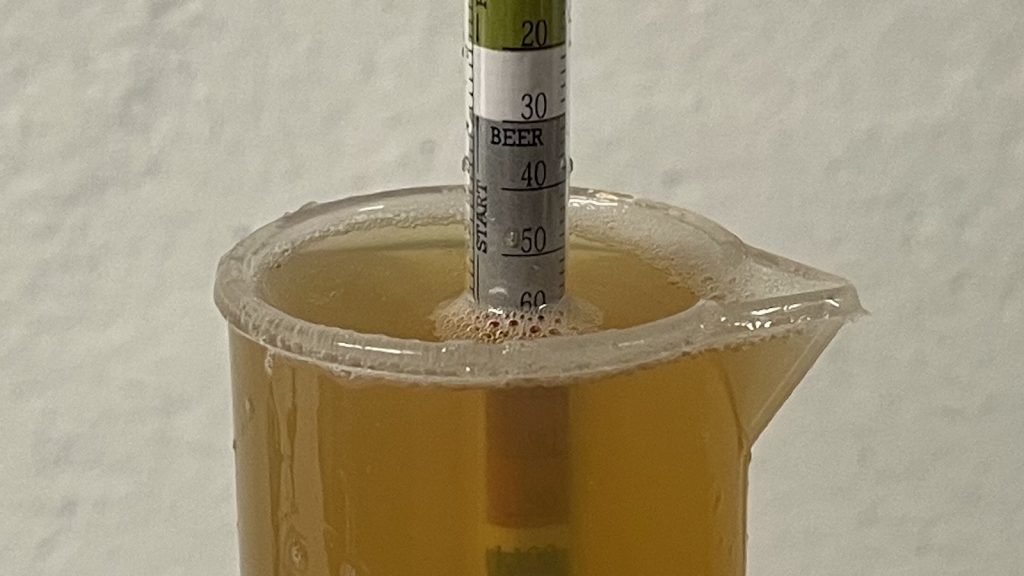
I then measured the pH of the chilled wort and found it was at 5.28.
Using a brewing calculator, I determined 2 mL of 88% lactic acid would reduce the pH of half of the total volume of wort to my target 5.0 pH, so I added that amount to one of the empty fermentation kegs.
After transferring identical volumes of wort to each fermenter, I measured the adjusted batch and found my calculations were pretty accurate.
With the worts at 64˚F/18˚C, I evenly split a starter of Imperial Yeast A07 Flagship between them.
After a couple days, I raised the temperature in my chamber to 68˚F/20˚C and allowed the beers to ferment for another week before I took pH measurements showing they were nearly identical. At this point, I pressure-transferred the beers onto dry hops in another set of CO2 purged kegs.
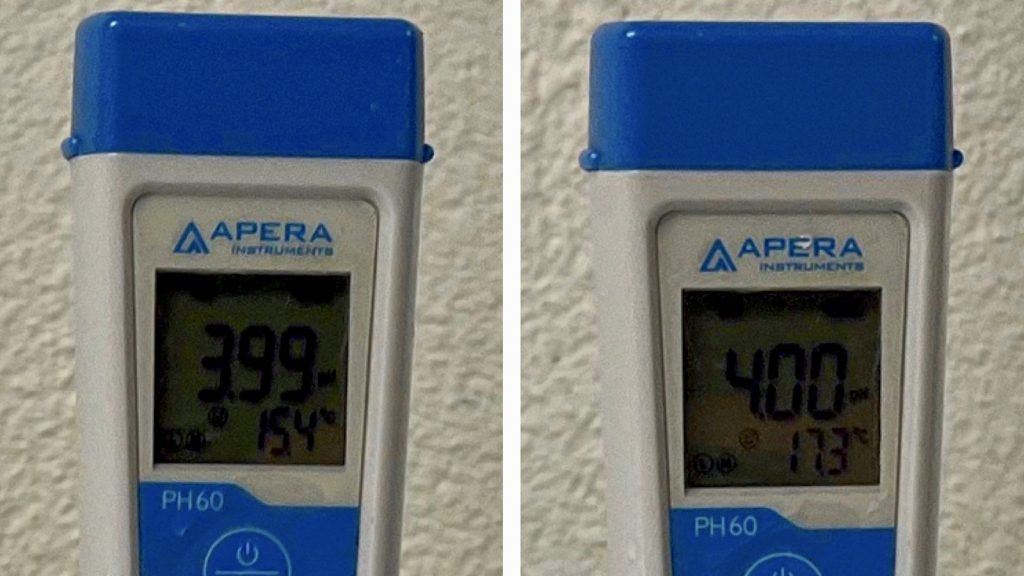
After 24 hours, I lightly pressurized the fermenters then reduced the chamber temperature to 32˚F/0˚C. Hydrometer measurements indicated a small difference in FG.
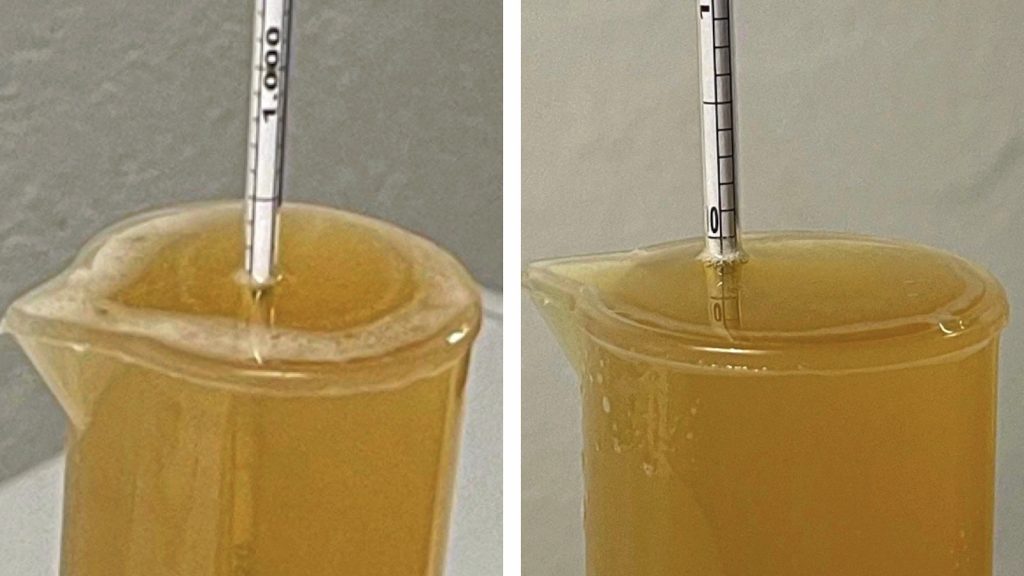
Following a 24 hour cold-crash, the beers were pressure-transferred to serving kegs, at which point I took a final pH measurement and found the difference had returned.
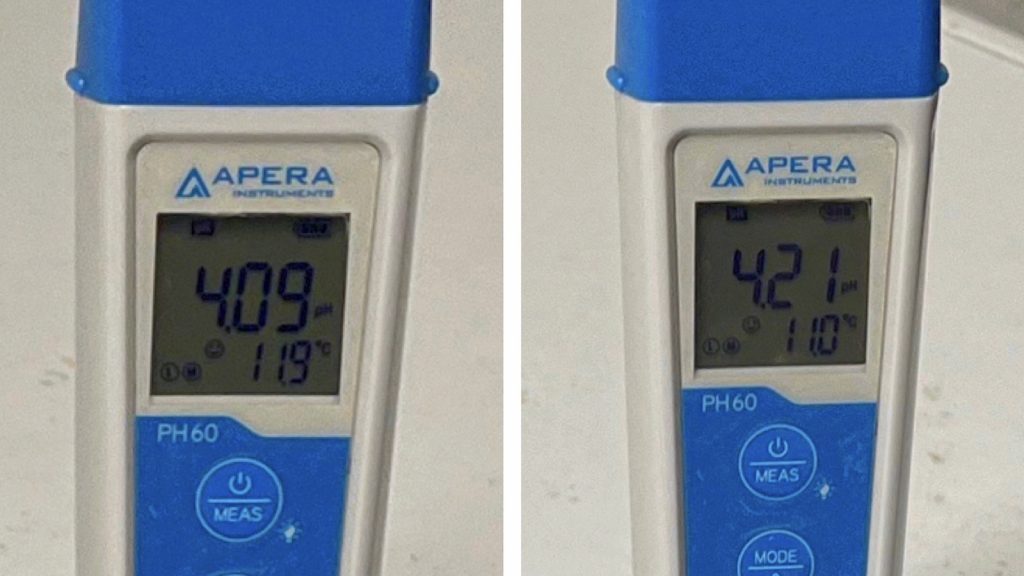
The filled kegs were placed in my keezer and burst carbonated overnight before I reduced the gas to serving pressure. After a week of conditioning, they were carbonated and ready for evaluation.
| RESULTS |
A total of 18 people of varying levels of experience participated in this xBmt. Each participant was served 1 sample of the beer where the wort was acidified post-boil and 2 samples of the beer where the wort was left unadjusted in different colored opaque cups then asked to identify the unique sample. While 10 tasters (p<0.05) would have had to accurately identify the unique sample in order to reach statistical significance, that’s exactly the number that did (p=0.043), indicating participants in this xBmt were able to reliably distinguish an American IPA where the wort was acidified to 5.0 pH post-boil from one where the wort was left unadjusted at approximately 5.3 pH.
The 10 participants who made the accurate selection on the triangle test were instructed to complete a brief preference survey comparing only the beers that were different. A total of 5 tasters reported preferring the beer where the wort was acidified post-boil while the other 5 said they liked the beer that was left unadjusted more.
My Impressions: Out of the 5 semi-blind triangle tests I attempted, I correctly identified the odd-beer-out every time. To my senses, the beer where the wort was acidified post-boil had a brighter hop flavor that exploded with fresh Centennial character, while unadjusted batch had a more “even” hop flavor. While both beers hit all the marks for what I look for in a modern American IPA, I had a slight preference for the version where the wort was acidified post-boil.
| DISCUSSION |
As brewers look for ways to maximize hop character in the various types of modern IPA, numerous novel methods have been developed, one of which involves acidifying wort following the boil and prior to pitching yeast. The fact tasters in this xBmt were able to reliably distinguish an American IPA where the wort was acidified post-boil to 5.0 pH from one that was left unadjusted at 5.3 pH indicates post-boil acidification may have a perceptible impact on hoppy ales.
While this data allows for minimal extrapolation regarding what exactly tasters perceived as being different, there’s evidence indicating dry hopping increases pH, and similar to other types of food, it’s possible adding exogenous acid to wort post-boil brings out brighter characteristics. Whether this is desirable or not is up to each drinker, as is evidenced by the split preference of participants who were correct on the triangle test. It’s also possible the effect of post-boil wort acidification is mediated by other factors such as hop variety, alcohol level, or yeast strain. Moreover, while the unadjusted batch had a higher post-boil pH, it wasn’t necessarily too high, so that may explain these results as well. Finally, there were a couple objectively observed differences, namely the better clarity and attenuation of the batch that was acidified post-boil, both of which would seem to be a function of the variable.
Brewing a batch of beer involves a number of steps, and while some may have a very real perceptible impact, it’s impossible to say whether it’s universally good or not. That’s how I feel about post-boil wort acidification following this xBmt, as it really did seem to change the character of the IPA, though both of these beers were excellent. Given my preference for the beer where the wort was acidified post-boil, slight as it was, I’ll continue using this method and look forward to comparing even greater post-boil pH differences in the future.
If you have any thoughts about this xBmt, please do not hesitate to share in the comments section below!
Support Brülosophy In Style!
All designs are available in various colors and sizes on Amazon!
Follow Brülosophy on:
FACEBOOK | TWITTER | INSTAGRAM
If you enjoy this stuff and feel compelled to support Brulosophy.com, please check out the Support page for details on how you can very easily do so. Thanks!


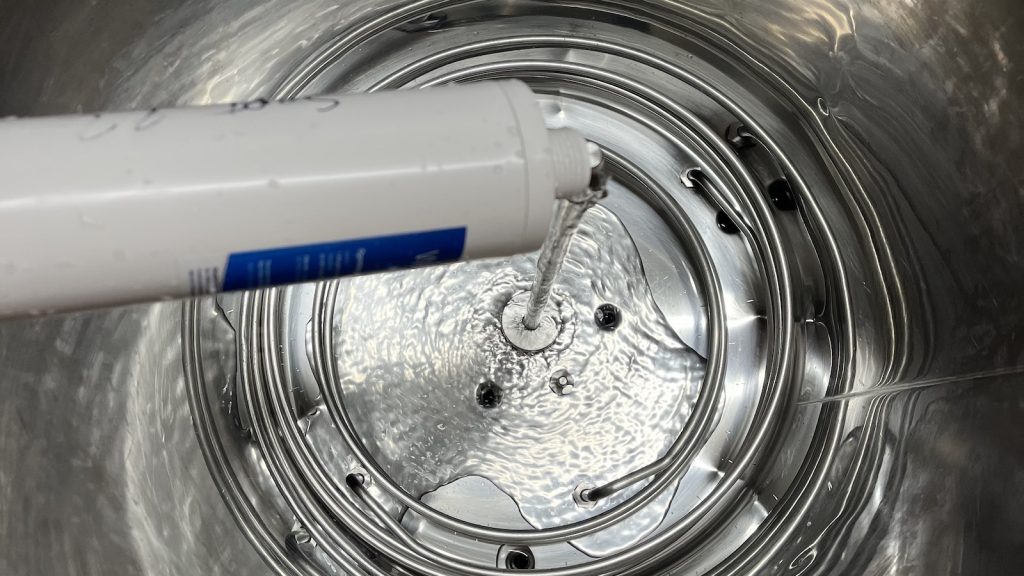
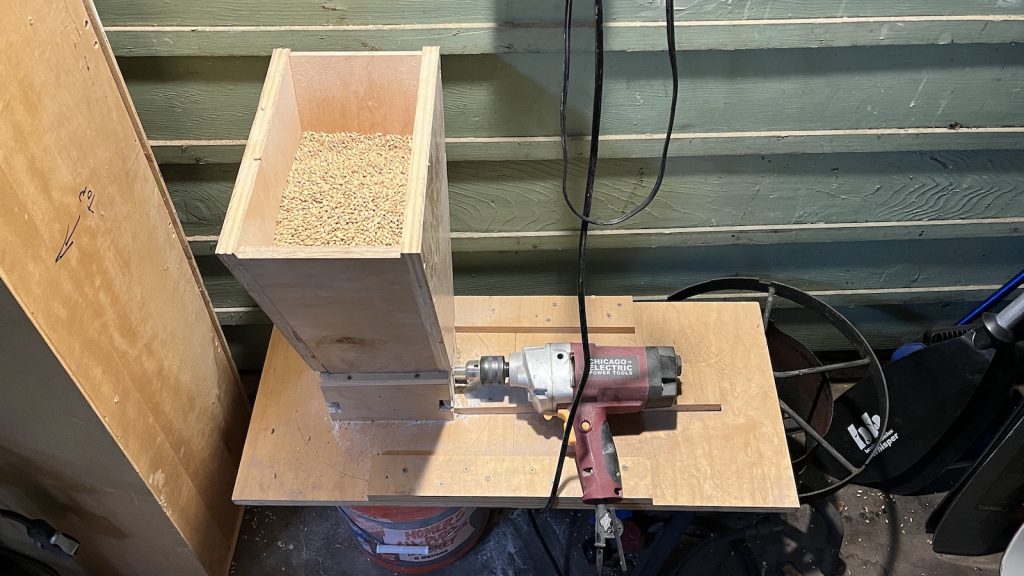
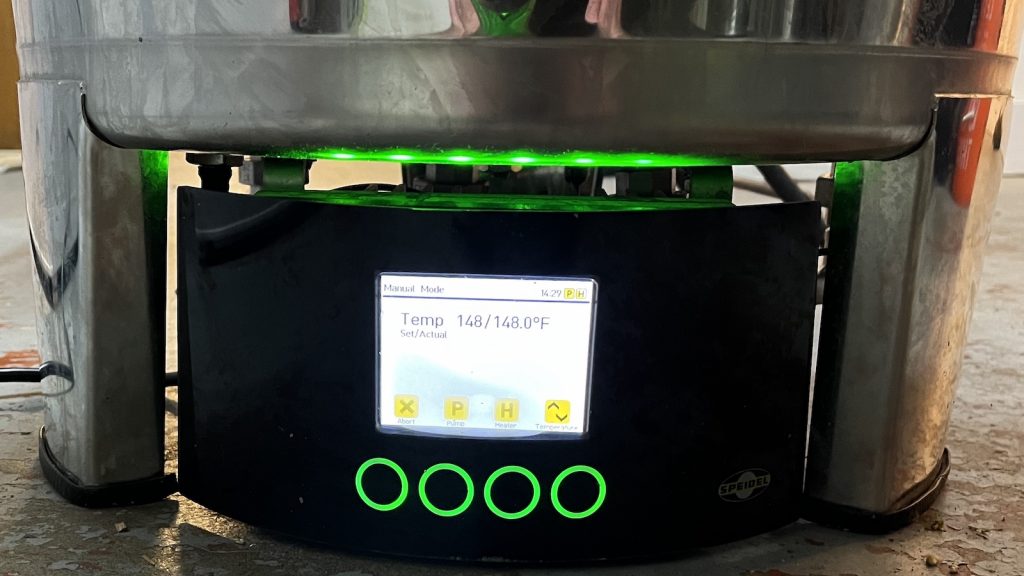
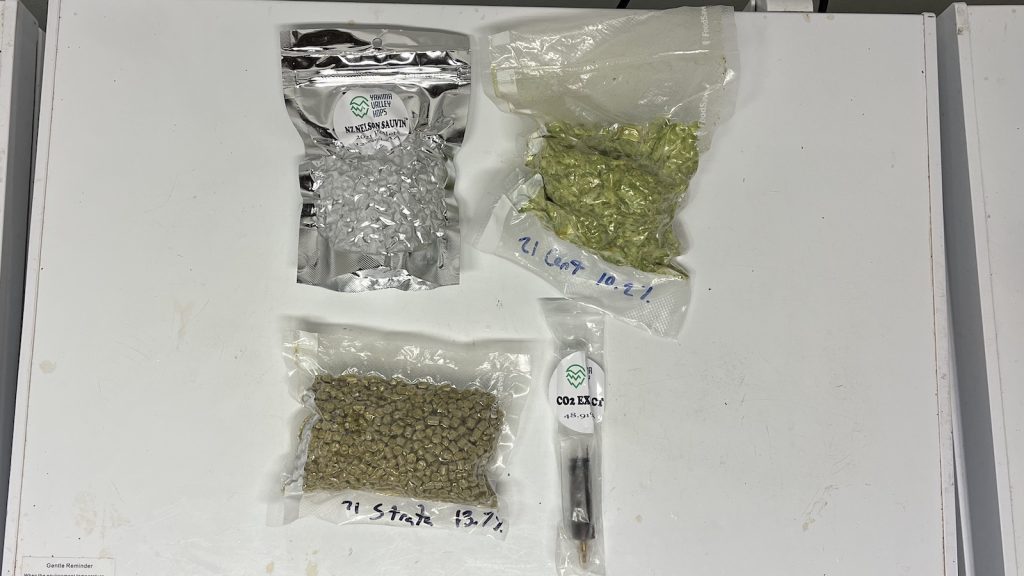
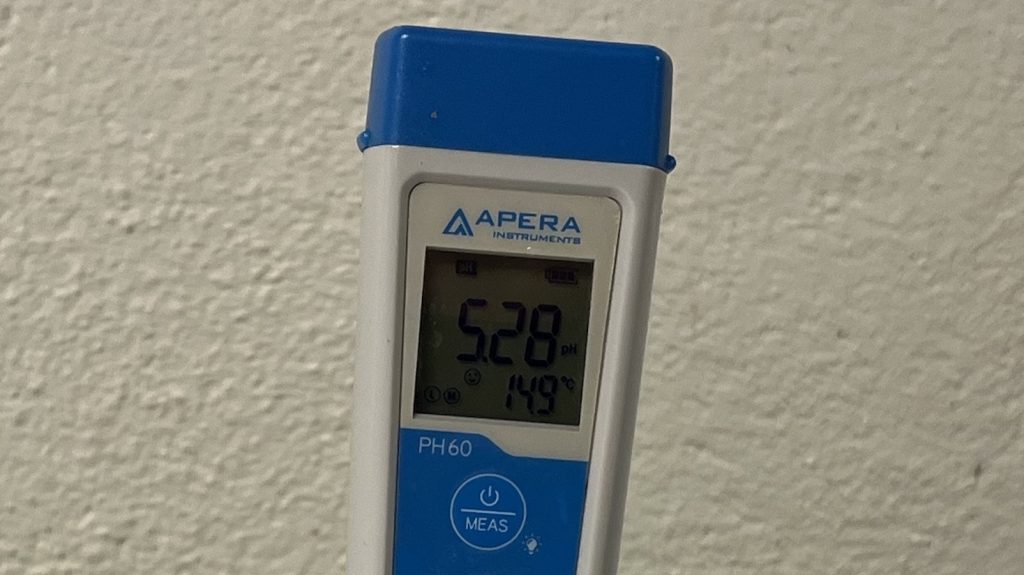
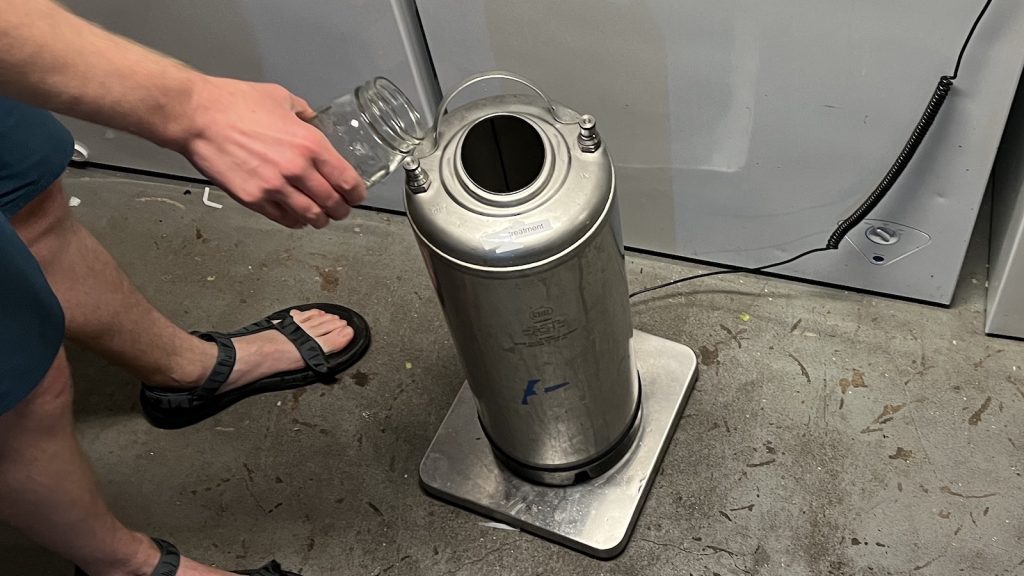
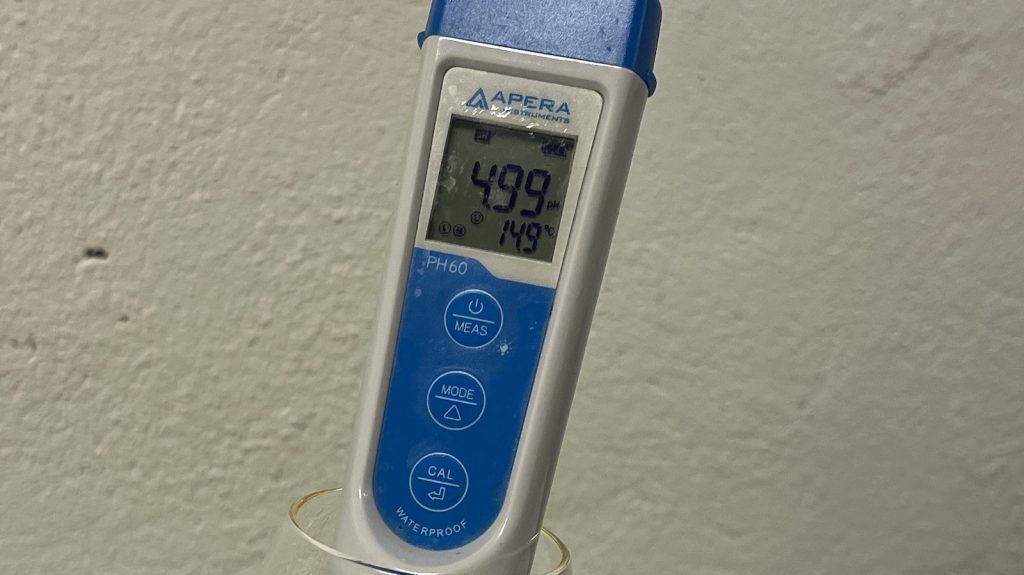
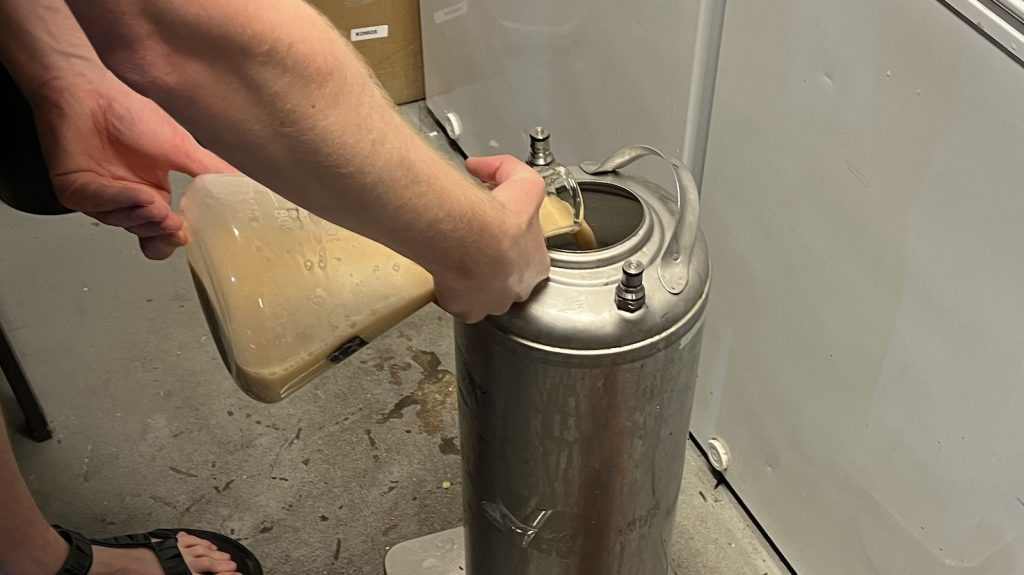
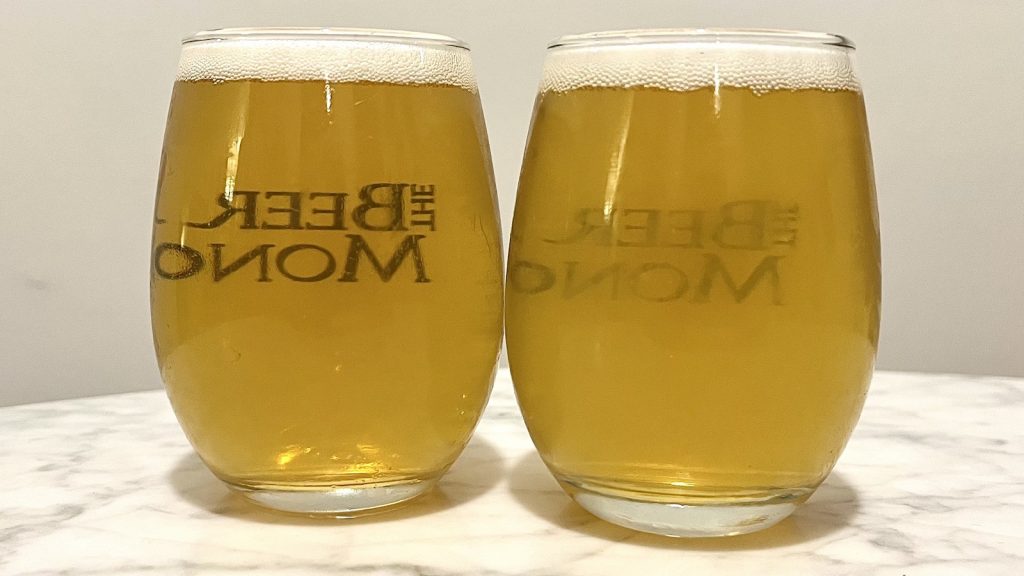











23 thoughts on “exBEERiment | Impact Post-Boil Acidification Has On An American IPA”
What calculator did you use for post-boil pH calculations?
I’m seeing several questions like Pete’s, so I’ll answer them all here. I kinda hacked Bru’n Water to calculate this. I just change the volume in the mash adjustment calculator (that I used to calculate mash additions) to my predicted knockout volume, then fuss with lactic acid adjustments until it gives me what I need to hit my desired knockout pH (and then I take the difference from how much was initially in the cell – which is the amount of lactic that it would take to acidify a mash of that volume to my natural post-boil pH. So if it that cell initially said 5ml = 5.3 pH, and it says 7ml = 5.0 pH, then I add the difference of 2ml lactic acid)
Thanks for the reply and the info. Cheers!
Caveat – Since the boil decreases pH, you probably need less acid than your calculator tells you to hit your target pH.
That being said, I use a calculator the same way you do, and it gets me in the right ballpark.
On that note, even I have found that 0.1 pH roughly equates to 1ml. In saying that, if you need to go from 5.5 for example to 5, instead of throwing 5mls straight at it, add half. It all depends on the alkalinity of the solution. Finally, I take my sample at 10 mins to go and add lactic or phosphoric as necessary. (Phos is more aggressive so less is needed).
What brewing calculator did you use to determine the amount of acid to add post-boil?
Do you think the higher attenuation of the adjusted beer impacted your preference? Or is it all down to ph?
I don’t think the higher attenuation was what drove my flavor preference (as I detected a different hop expression and wasn’t really able to isolate dryness as the difference on my palate). That being said, the extra attenuation was a welcome benefit! I like my IPAs dry as a bone – and this experiments suggests that acidification might help promote that.
I’ve been having success lately with adding lactic acid when kegging after dry hopping
Dry hopping increases PH about 0.05 to 0.10 depending on how heavy a dry hop is done
I haven’t messed around with adding lactic post boil though, only post fermentation.
The thing that’s nice about doing it post fermentation is you can take a sample, taste it and adjust with acid based on the flavor. I find that an ideal finished PH number varies significantly depending on a lot of variables in the recipe, so doing it based on taste works great.
I also fudge brun water to yield the approximate dosage too! I use a syringe with a long needele and add the lactic acid to my purged keg via the PRV while maintaining positive pressure of 5 PSI in the keg. If you use a floating diptube then hook the gas to your liquid line so you keep positive pressure from the bottom up.
Fonseca PH of 4.0 seems pretty low though. I’ve had success at ~4.4
Maybe I could go lower in some cases?
How did you calculate the amount of lactic to add to the wort?
Thank you for sharing your experimental design as well as your results. I’ve often used acid to lower the pH of word in my beers. What calculator did you use to determine the volume of acid needed to achieve your desired pH?
Hack Bru’n water
Use Bru’n Water and make the mash size 6 gallons (or whatever your final boil volume is). Set sparge volume to zero for the hack
Fudge the grain addition to hit whatever your measured PH is before adding additional acid.
Play around with the lactic acid parameter until it gets you to your target. Then add however much it says to add.
I personally make these adjustments after dry hopping & fermentation rather than post boil.
The calculation is a little easier because I can see exactly what my volume is in the fermenter. I can also adjust to taste. Final PH is a range and not a hard/fast rule for every beer/yeast
The clarity difference is astounding. Thank you for performing this experiment, I have been curious about acidifying my wort for a while now. I think I’ll add 2mL lactic acid to my IPA that is currently fermenting.
To make life simpler, I use citric acid powder for my dry hop pH adjustment. I usually prep my dry hops on brew day and put them in a bag in my freezer. Since citric acid is in powder form, I add it to the bag with my dry hops and just dump the whole thing in the fermenter when it comes time to add my dry hops.
Is there any other way to calculate post-boil acid pH adjustments than Brun’Water? I don’t have Excel or Brun’water.
LibreOffice is free and Bru’n Water works very well in it. Bru’n Water has a free version, but the donation/paid version he provides is better.
All of the popular brewing software providers now have water adjustment calculators built into them. BrewFather has a free version which includes this feature, for example. One good rule of thumb for a 5-gallon batch is adding 4ml of lactic acid at flameout – that should be more than sufficient for most batches
Hey Jordan, I am planning to brew this recipe soon and just have a couple questions:
1. Did you prefer the Strata substitute, or would you go back to using Citra?
2. What would you recommend for a 60 min hop addition in place of the hop shot?
Thanks,
Taylor
1. Strata was awesome, but I’d say use Citra for your first go at this recipe.
2. Any low cohumulone/high alpha hop (e.g., Simcoe, Warrior, Magnum)
Thanks!
I just listened to both the post-boil pH adjustment episode AND this honey episode of the podcast (with Will Lovell), and am curious about how the two will affect each other in an upcoming brew I have planned. I’m planning my first go at a hazy DIPA (I’m typically a 65-70 IBU, clear & dry IPA kinda guy, but want to try my hand at something different). My recipe contains a bit of honey, which I’m going to add in the last few minutes of the boil. I think I may measure the pH before adding the honey and after as well, to see what effect the honey has on the pH, since honey does have a pH that’s a bit acidic. Maybe adding acid isn’t totally necessary depending on the quantity of honey used!
Matt M, measuring the PH before and after the honey addition is the way to go! Don’t fry your PH meter though
I keep very small glass jars in my freezer so I can quickly cool down samples of boiling water. For mash samples, one jar usually cool it down nicely. For boiling wort I general need to use two of the jars or I just run the sealed jar under cool tap water.
Sometimes you would be surprised at how much PH drops during a boil.
My practice currently is to take a PH reading before the whirlpool and acidify as needed prior to the whirlpool. Then I take a second reading after the whirlpool and acidify more as needed. Different varieties and quantities of whirlpool hops spike PH differently which is why I like doing the reading before and after WP.
I also highly recommend taking PH readings before and after dry hopping (assuming you have a way to take samples without oxidizing your wort).
I general find a heavy dry hop spikes PH at least 0.10. In my experience 3ml of lactic acid is enough to drop the PH back down to the pre dry hop PH. However, all post fermentation PH adjustments should really be done to taste.
Hi Matt! I’ve never tested pH following honey additions – heck don’t know if I’ve ever even added honey to a beer. Please measure your wort pH before and after adding it, and let us know what you observe. Fun idea!